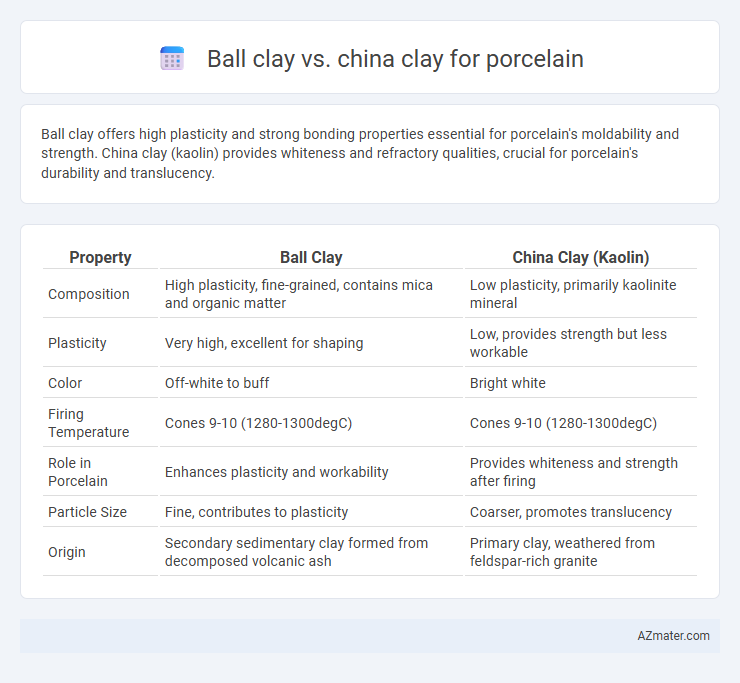Ball clay offers high plasticity and strong bonding properties essential for porcelain's moldability and strength. China clay (kaolin) provides whiteness and refractory qualities, crucial for porcelain's durability and translucency.
Table of Comparison
| Property | Ball Clay | China Clay (Kaolin) |
|---|---|---|
| Composition | High plasticity, fine-grained, contains mica and organic matter | Low plasticity, primarily kaolinite mineral |
| Plasticity | Very high, excellent for shaping | Low, provides strength but less workable |
| Color | Off-white to buff | Bright white |
| Firing Temperature | Cones 9-10 (1280-1300degC) | Cones 9-10 (1280-1300degC) |
| Role in Porcelain | Enhances plasticity and workability | Provides whiteness and strength after firing |
| Particle Size | Fine, contributes to plasticity | Coarser, promotes translucency |
| Origin | Secondary sedimentary clay formed from decomposed volcanic ash | Primary clay, weathered from feldspar-rich granite |
Introduction to Ball Clay and China Clay
Ball clay, composed primarily of kaolinite along with mica and quartz, is prized for its plasticity and fine particle size, making it essential in porcelain production for enhancing workability and strength. China clay, also known as kaolin, consists mainly of pure kaolinite, offering whiteness and chemical inertness critical for achieving translucency and a smooth surface in high-quality porcelain. The balanced combination of ball clay's plasticity and china clay's purity is vital in formulating porcelain with optimal texture, strength, and aesthetic appeal.
Key Differences Between Ball Clay and China Clay
Ball clay exhibits greater plasticity and finer particle size compared to China clay, making it essential for improving the strength and flexibility of porcelain bodies. China clay, also known as kaolin, contains higher alumina content and lower impurities, which enhances whiteness and firing stability in porcelain production. The key differences lie in their mineral composition, plasticity, and firing characteristics, with ball clay contributing plasticity and workability, while China clay provides whiteness and structural integrity.
Composition and Mineralogy
Ball clay is primarily composed of kaolinite, mica, and quartz, with a high plasticity due to its fine particle size and substantial organic impurities, making it ideal for enhancing the workability of porcelain bodies. China clay, also known as kaolin, consists mainly of pure kaolinite with minimal impurities, offering excellent whiteness and refractory properties essential for achieving translucency and strength in porcelain. The mineralogical differences affect plasticity, firing temperature, and final texture, with ball clay contributing plasticity and strength, while china clay provides whiteness and thermal resistance.
Physical Properties Comparison
Ball clay has finer particle size and higher plasticity compared to China clay, making it more suitable for shaping and molding in porcelain production. China clay, also known as kaolin, features higher purity and greater whiteness, contributing to the translucency and strength of porcelain. The lower iron content in China clay reduces discoloration during firing, while ball clay's higher flux content aids in vitrification and improves the mechanical strength of the finished porcelain.
Plasticity: Impact on Porcelain Production
Ball clay exhibits higher plasticity compared to China clay, making it essential for shaping and forming porcelain due to its excellent workability and flexibility. The increased plasticity of ball clay enhances the green strength of porcelain bodies, reducing cracking during drying and firing processes. In contrast, China clay, with lower plasticity and higher purity, contributes to whiteness and translucency but requires blending with ball clay to optimize plasticity for porcelain production.
Firing Behavior in Porcelain Manufacturing
Ball clay exhibits higher plasticity and finer particle size compared to China clay, enhancing the workability and green strength of porcelain bodies during shaping. China clay, or kaolin, has higher refractoriness and lower flux content, which contributes to better structural stability and whiteness but requires higher firing temperatures. In porcelain manufacturing, understanding the complementary firing behaviors of ball clay and China clay is essential to optimizing vitrification, minimizing shrinkage, and achieving the desired translucency and mechanical strength.
Color and Whiteness after Firing
Ball clay and China clay differ significantly in color and whiteness after firing in porcelain production; China clay, also known as kaolin, typically yields a brighter, whiter appearance due to its higher purity and lower iron content. Ball clay contains more organic matter and impurities, resulting in a creamier or slightly off-white color after firing. The superior whiteness of China clay is essential for achieving the classic translucent and pure white porcelain finish.
Common Applications in Porcelain Industry
Ball clay and China clay both play essential roles in the porcelain industry by enhancing different properties of the final product. Ball clay is primarily used for its plasticity and bonding capabilities, improving workability and strength during shaping and drying processes. China clay, or kaolin, contributes to the whiteness, translucency, and high firing temperature resistance, making it crucial for porcelain's aesthetic and durability qualities.
Pros and Cons of Ball Clay vs China Clay
Ball clay offers high plasticity and excellent binding properties, making it ideal for porcelain's shape retention during molding, but it contains higher impurities like iron which can affect color and firing results. China clay, or kaolin, provides superior whiteness and purity, crucial for the translucency and strength of porcelain, though it has lower plasticity and requires blending with other clays like ball clay for workability. Using ball clay enhances flexibility and workability but may reduce whiteness, whereas china clay boosts porcelain's brightness and durability at the cost of reduced plasticity.
Choosing the Right Clay for Porcelain
Ball clay offers high plasticity and fine particle size, making it ideal for achieving smooth, workable porcelain bodies with excellent strength and durability. China clay, also known as kaolin, provides purity and whiteness, crucial for the translucency and bright finish of fine porcelain ware. Selecting the right clay depends on the desired properties; combining ball clay's plasticity with china clay's whiteness often yields the optimal porcelain composition for both aesthetic appeal and functional performance.

Infographic: Ball clay vs China clay for Porcelain
 azmater.com
azmater.com